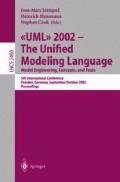Abstract
Design metrics are useful means for improving the quality of software. A number of object-oriented metrics have been suggested as being helpful for resource allocation in software development. These metrics are particularly useful for identifying fault-prone classes and for predicting required maintenance efforts, productivity, and rework efforts. To obtain the design metrics of the software under development, most existing approaches measure the metrics by parsing the source code of the software. Such approaches can only be performed in a late phase of software development, thus limiting the usefulness of the design metrics in resource allocation. In this paper, we present a methodology that compiles UML specifications to obtain design information and to compute the design metrics at an early stage of software development. The current version of our tool uses diagrams produced by the Rational Rose tool and computes OO metrics that have been suggested as being good indicators for identifying faults related to Object- Oriented features. Our technique advances the state of the metrics measuring process; thus it is expected to strongly promote the use of design metrics and significantly increase their impact on improving software quality.
Access this chapter
Tax calculation will be finalised at checkout
Purchases are for personal use only
Preview
Unable to display preview. Download preview PDF.
References
Abdurazik and J. Offutt. Using UML collaboration diagrams for static checking and test generation. In Proceedings of UML 2000, 2000.
V. R. Basili, L. C. Briand, and W. L. Melo. A validation of object-oriented design metrics as quality indicators. IEEE Transactions on Software Engineering, 22(10):751–761, October 1996.
L. Briand, P. Devanbu, and W. Melo. An investigation into coupling measures for c++. Technical Report ISERN-96-08, ISERN, 1996.
L. C. Briand, S. Morasca. Defining and validating measures for object-based high-level design. IEEE Transactions on Software Engineering, 25(5):722–743, September 1999.
S. R. Chidamber, D. P. Darcy, and C. F. Kemerer. Managerial use of metrics for object-oriented software: An exploratory analysis. In IEEE Transactions on Software Engineering, 24(8):629–639, August 1998.
S. R. Chidamber and C. F. Kemerer. A metrics suite for object oriented design. IEEE Transactions on Software Engineering, 20(6):476–493, June 1994.
M. K. Daskalantonakis. A practical view of software measurement and implementation experiences within Motorola. In IEEE Transactions on Software Engineering, 18(11):998–1010, 1992.
R. B. Grady. Work-Product Analysis: The Philosopher’s Stone of Software? In IEEE Software, 7(2):26–34, 1990.
R. Harrison and S. J. Counsell. An evaluation of the mood set of object-oriented software metrics. IEEE Transactions on Software Engineering, 21(12):929–944, December 1995.
W. Harrison. Using software metrics to allocate testing resources. Journal of Management Information Systems, 4(4):93–105, 1988.
S. Henry and C. Selig. Predicting source-code complexity at the design stage. In IEEE Software, 7(2):36–44, 1990.
IntegriSoft Inc. iSight++. http://www.integrisoft.com/isight.htm
JMetric. http://www.jmetric.com/
Kao, M. H. Tang, and M. H. Chen. Investigating test effectiveness on objectoriented software—a case study. In Proceedings of Twelfth Annual International Software Quality Week, 1999.
W. Li. Another metric suite for object-oriented programming. Journal of Systems and Software, 44:155–162, 1998.
W. Li and S. Henry. Object-oriented metrics that predict maintainability. Journal of Systems and Software, 23:111–122, 1993.
M. Lorenz and J. Kidd. Object-Oriented Software Metrics. Prentice Hall Inc., 1994.
M Squared Technologies. Resource Standard Metrics. http://m2tech.net/rsm/
Number Six Software Inc. Metrics One. http://www.numbersix.com/Extras/MetricsOne.asp
J. Offutt and A. Abdurazik. Generating tests from UML specification. In Proceedings of UML’99, 1999.
Object Management Group. OMG UML Specification Version 1.3. June 1999.
Porter, R. W. Selby. Empirically guided software development using metricbased classification trees. In IEEE Software, 7(2):46–54, 1990.
Rational Software Corporation. Using Rational Rose. 2001.
H. D. Rombach. Design measurement: some lessons learned. IEEE Software, 7(2):17–25, 1990.
K. Siau, and Q. Cao. Unified Modeling Language—a complexity analysis. Journal of Database Management, 12(1):26–34, Jan–Mar 2001
Sitraka Inc. Jprobe Suite. http://www.sitraka.com/software/jprobe/
SOFTEAM. Objecteering/UML Enterprise Edition. http://www.objecteering.com
M. H. Tang, M. H. Kao and M. H. Chen. An empirical study of object-oriented metrics. In Proceedings of 6 th IEEE International Software Metrics Symposium, 1999.
M. H. Tang, and M. H. Chen. Algorithms for measuring object-oriented design metrics from Rational Rose model. SUNYA CS Technical Report TR-02-4.
TogetherSoft. Together Control Center v5.5. http://www.togethersoft.com
WebGain Inc. WebGain Studio. http://www.webgain.com/products/webgain_studio/
Author information
Authors and Affiliations
Editor information
Editors and Affiliations
Rights and permissions
Copyright information
© 2002 Springer-Verlag Berlin Heidelberg
About this paper
Cite this paper
Tang, MH., Chen, MH. (2002). Measuring OO Design Metrics from UML. In: Jézéquel, JM., Hussmann, H., Cook, S. (eds) ≪UML≫ 2002 — The Unified Modeling Language. UML 2002. Lecture Notes in Computer Science, vol 2460. Springer, Berlin, Heidelberg. https://doi.org/10.1007/3-540-45800-X_29
Download citation
DOI: https://doi.org/10.1007/3-540-45800-X_29
Published:
Publisher Name: Springer, Berlin, Heidelberg
Print ISBN: 978-3-540-44254-7
Online ISBN: 978-3-540-45800-5
eBook Packages: Springer Book Archive

